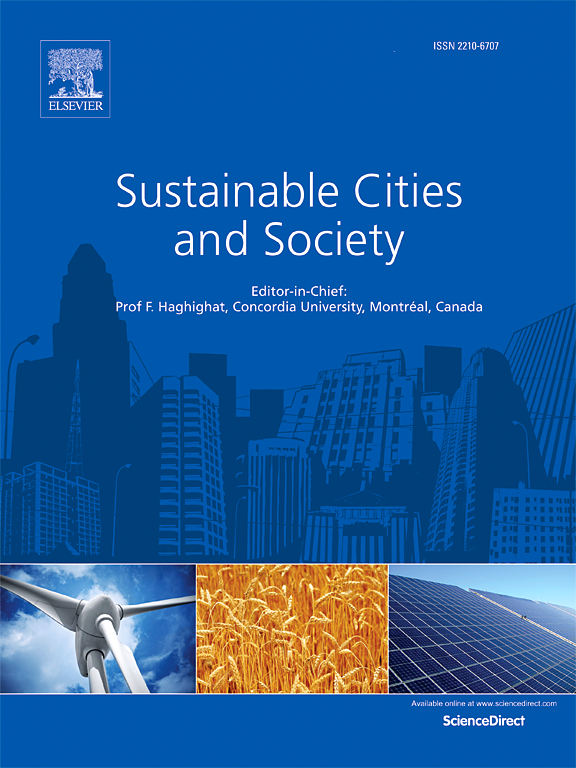包含自然灾害下建筑物二氧化碳当量成本的综合生命周期成本评估框架
IF 10.5
1区 工程技术
Q1 CONSTRUCTION & BUILDING TECHNOLOGY
引用次数: 0
摘要
建筑行业占全球温室气体(GHG)排放量的约39%,使用二氧化碳当量(CO2e)进行量化。随着城市化和人口增长,建筑需求不断上升,可持续发展的考虑变得至关重要。本研究提出了一个新的从摇篮到摇篮的生命周期成本评估框架,该框架整合了可持续性的三大支柱:经济、环境和社会;同时在整个结构的设计寿命中考虑与自然灾害相关的损失。该框架以货币形式量化经济(例如,材料和工艺成本)、环境(例如,二氧化碳当量)和社会(例如,伤亡和伤害)影响。该框架还通过环境成本深入分析了未来不同气候情景下二氧化碳当量的影响。该框架在印度的四座钢框架建筑中进行了演示,这些建筑暴露在地震事件中作为自然灾害。研究发现,初始成本和运营成本在生命周期成本中占主导地位,其次是初始碳排放和运营碳排放。此外,与二氧化碳当量相关的成本占总生命周期成本的30%至70%,具体取决于未来的气候情景。研究结果强调,需要制定政策,利用这一框架在业主、承包商、建筑师、工程师、城市规划者和政策制定者等多个利益相关者之间评估可持续设计和施工。本文章由计算机程序翻译,如有差异,请以英文原文为准。
An integrated life cycle cost assessment framework incorporating cost of carbon dioxide equivalent for buildings subjected to natural hazards
The building construction industry is responsible for approximately 39 % of global greenhouse gas (GHG) emissions, quantified using carbon dioxide equivalent (CO2e). As urbanization and population growth escalate construction demand, sustainable development considerations become crucial. This study presents a novel cradle-to-cradle life cycle cost assessment framework that integrates the three pillars of sustainability: economic, environmental, and social; while accounting for natural hazard-related losses throughout a structure’s design life. The framework quantifies economic (e.g., material and process costs), environmental (e.g., CO2e) and social (e.g., casualties and injuries) impacts in monetary terms. The framework also provides insights into CO2e impacts under different future climate scenarios through environmental costs. The framework is demonstrated for four steel frame buildings in India exposed to seismic events as natural hazards. The study finds that initial and operational costs dominate life cycle costs, followed by initial carbon emissions and operational carbon emissions. Further, costs associated with CO2e account for 30 % to 70 % of total life cycle cost, depending on the future climate scenarios. The findings highlight the need for policies that utilize this framework for evaluating sustainable design and construction among multiple stakeholders such as owners, contractors, architects, engineers, urban planners and policymakers.
求助全文
通过发布文献求助,成功后即可免费获取论文全文。
去求助
来源期刊

Sustainable Cities and Society
Social Sciences-Geography, Planning and Development
CiteScore
22.00
自引率
13.70%
发文量
810
审稿时长
27 days
期刊介绍:
Sustainable Cities and Society (SCS) is an international journal that focuses on fundamental and applied research to promote environmentally sustainable and socially resilient cities. The journal welcomes cross-cutting, multi-disciplinary research in various areas, including:
1. Smart cities and resilient environments;
2. Alternative/clean energy sources, energy distribution, distributed energy generation, and energy demand reduction/management;
3. Monitoring and improving air quality in built environment and cities (e.g., healthy built environment and air quality management);
4. Energy efficient, low/zero carbon, and green buildings/communities;
5. Climate change mitigation and adaptation in urban environments;
6. Green infrastructure and BMPs;
7. Environmental Footprint accounting and management;
8. Urban agriculture and forestry;
9. ICT, smart grid and intelligent infrastructure;
10. Urban design/planning, regulations, legislation, certification, economics, and policy;
11. Social aspects, impacts and resiliency of cities;
12. Behavior monitoring, analysis and change within urban communities;
13. Health monitoring and improvement;
14. Nexus issues related to sustainable cities and societies;
15. Smart city governance;
16. Decision Support Systems for trade-off and uncertainty analysis for improved management of cities and society;
17. Big data, machine learning, and artificial intelligence applications and case studies;
18. Critical infrastructure protection, including security, privacy, forensics, and reliability issues of cyber-physical systems.
19. Water footprint reduction and urban water distribution, harvesting, treatment, reuse and management;
20. Waste reduction and recycling;
21. Wastewater collection, treatment and recycling;
22. Smart, clean and healthy transportation systems and infrastructure;
 求助内容:
求助内容: 应助结果提醒方式:
应助结果提醒方式:


